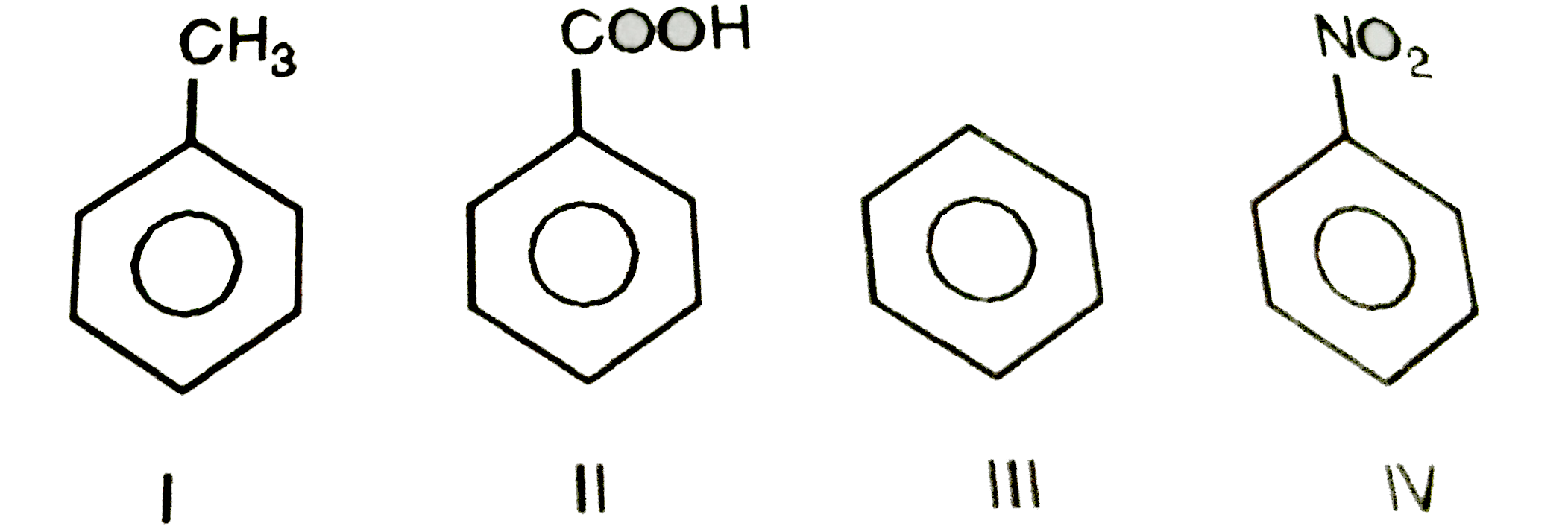Which of the following orders is not correct for the decreasing order of acidic character ?
CH3CH2CH(Cl)COOH>CH3CH(Cl)CH2COOH>CH2(Cl)CH2CH2COOH>CH3CH2CH2COOH
ICH2COOH>BrCH2COOH>ClCH2COOHbtFCH2COOH
CCl3COOH>CHCl2COOH>CH2ClCOOH>CH3COOH
HCOOH>CH3COOH>C2H5COOH>(CH3)2CHCOOH
The correct Answer is:B
To determine which of the following orders is not correct for the decreasing order of acidic character, we need to analyze the given options based on the inductive effect of the substituents attached to the carbon chain. The acidic character of compounds is influenced by the presence of electronegative atoms that can stabilize the negative charge on the conjugate base formed after deprotonation.
1. Understanding Acidic Character:
- The acidic character of a compound is influenced by the stability of its conjugate base. The more stable the conjugate base, the stronger the acid.
- Electronegative substituents (like Cl, Br, I, F) exert a negative inductive effect (-I), which stabilizes the conjugate base and increases acidity.
2. Analyzing the First Option:
- The first option involves chlorine attached to different carbon atoms in a chain.
- The -I effect decreases with distance from the acidic group (COOH). Therefore, the order based on the position of Cl should be correct.
- This order is valid, so it is not the answer.
3. Analyzing the Second Option:
- The second option compares Iodine, Bromine, Chlorine, and Fluorine attached to the same carbon.
- The order of -I effect is F > Cl > Br > I. Hence, the order of acidity should be F > Cl > Br > I.
- If the given order contradicts this, it is incorrect. This option is likely the answer.
4. Analyzing the Third Option:
- This option compares compounds with varying numbers of chlorine atoms.
- More -I groups (chlorine atoms) increase the acidity. Thus, the order should be correct.
- This option is valid, so it is not the answer.
5. Analyzing the Fourth Option:
- The fourth option involves alkyl groups (CH3, C2H5, etc.) with no electronegative substituents.
- Alkyl groups exert a +I effect, which decreases acidity. Therefore, the order should be correct as larger alkyl groups decrease acidity.
- This option is also valid, so it is not the answer.
6. Conclusion:
- The second option is the only one that contradicts the expected order of acidity based on the -I effect of the substituents. Therefore, it is the incorrect order.
Final Answer:
The order that is not correct for the decreasing order of acidic character is the second option (Iodine, Bromine, Chlorine, Fluorine).
- The acidic character of a compound is influenced by the stability of its conjugate base. The more stable the conjugate base, the stronger the acid.
- Electronegative substituents (like Cl, Br, I, F) exert a negative inductive effect (-I), which stabilizes the conjugate base and increases acidity.
- The first option involves chlorine attached to different carbon atoms in a chain.
- The -I effect decreases with distance from the acidic group (COOH). Therefore, the order based on the position of Cl should be correct.
- This order is valid, so it is not the answer.
- The second option compares Iodine, Bromine, Chlorine, and Fluorine attached to the same carbon.
- The order of -I effect is F > Cl > Br > I. Hence, the order of acidity should be F > Cl > Br > I.
- If the given order contradicts this, it is incorrect. This option is likely the answer.
- This option compares compounds with varying numbers of chlorine atoms.
- More -I groups (chlorine atoms) increase the acidity. Thus, the order should be correct.
- This option is valid, so it is not the answer.
- The fourth option involves alkyl groups (CH3, C2H5, etc.) with no electronegative substituents.
- Alkyl groups exert a +I effect, which decreases acidity. Therefore, the order should be correct as larger alkyl groups decrease acidity.
- This option is also valid, so it is not the answer.
- The second option is the only one that contradicts the expected order of acidity based on the -I effect of the substituents. Therefore, it is the incorrect order.
The order that is not correct for the decreasing order of acidic character is the second option (Iodine, Bromine, Chlorine, Fluorine).
Topper's Solved these Questions
- ALDEHYDES, KETONES AND CARBOXYLIC ACIDSBOOK - NCERT FINGERTPS ENGLISHCHAPTER - ALDEHYDES, KETONES AND CARBOXYLIC ACIDSEXERCISE - NCERT ( EXEMPLAR PROBLEMS )
11 Videos
- ALDEHYDES, KETONES AND CARBOXYLIC ACIDSBOOK - NCERT FINGERTPS ENGLISHCHAPTER - ALDEHYDES, KETONES AND CARBOXYLIC ACIDSEXERCISE - ASSERTION & REASON
15 Videos
- ALDEHYDES, KETONES AND CARBOXYLIC ACIDSBOOK - NCERT FINGERTPS ENGLISHCHAPTER - ALDEHYDES, KETONES AND CARBOXYLIC ACIDSEXERCISE - MCQs( PHYSICAL PROPERTIES )
2 Videos
- ALCOHOLS,PHENOLS AND ETHERSBOOK - NCERT FINGERTPS ENGLISHCHAPTER - ALCOHOLS,PHENOLS AND ETHERSEXERCISE - Assertion And Reason
14 Videos
- AMINES BOOK - NCERT FINGERTPS ENGLISHCHAPTER - AMINES EXERCISE - ASSERTION & REASON CORNER
14 Videos
Similar Questions
Knowledge Check
Which of the following options shows the correct order of decreasing acidity:
A(CH3)3COH>(CH3)2CHOH>C2H5OH>CH3OHBCH3OH>C2H5OH>(CH3)2CHOH>(CH3)3COHCC2H5OH>CH3OH<(CH3)3COH>(CH3)2CHOHD(CH3)2CHOH>(CH3)3COH>C2H5OH>CH3OH
The correct order of acidic character is
View SolutionThe correct order of acidic character is
View SolutionThe decreasing order of the basic character is :
View SolutionWhich of the following is not correct decreasing ka order .
View SolutionWhich of the following order is correct for the decreasing reactivity to ring monobromination of the following compounds?

View SolutionWhich is correct in increasing order of ionic character ?
View SolutionWhich of the following options shows the correct order of decreasing acidity:
View Solution

 .
.